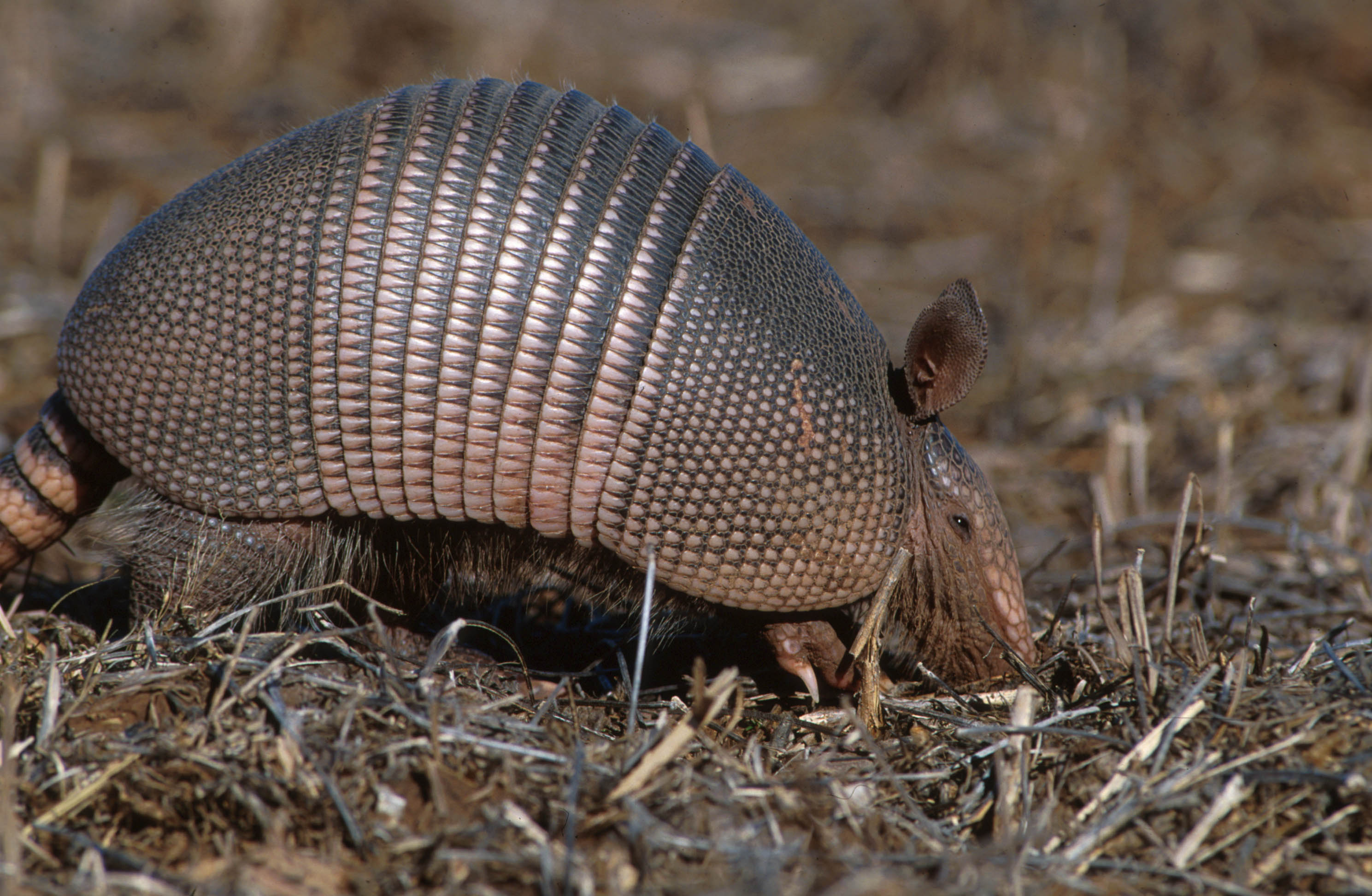SCIENTIFIC NAME:
Dasypus novemcinctus
OTHER NAMES:
Armadillo, Common Long-Nosed Armadillo
DESCRIPTION:
The nine-banded armadillo (Dasypus novemcinctus) cannot easily be confused with any other North American wild mammal. The armadillo’s body is covered with an armored carapace or shell. The carapace is a double layer of horn and bone, segmented into three main divisions: an anterior scapular shield covering the shoulder; a posterior pelvic shield covering the hip region; and a middle section comprised of a series of bands connected by soft, infolded skin between the bands. The head and legs are covered with thick scales, and the tail is encased in a series of bony rings.
Coloration of nine-banded armadillos is generally grayish brown, with yellowish-white scales along the side of the carapace. The armadillo has a long, pointed snout, small eyes, and large, cylindrical ears. The armadillo’s pointed snout, short, stout legs, and heavy claws are well suited for digging and burrowing.
Armadillos have a limited number of vocalizations: a low, wheezy grunt associated with digging and rooting; a wheezy grunt uttered by recently captured individuals; an audible buzzing noise given when highly alarmed or fleeing, a pig-like squeal given by frightened individuals; and a weak purring given by young attempting to nurse from an unrelated female.
Total length ranges from 24 to 31 inches and weights vary from 8 to 15 pounds. There are six subspecies of Dasypus novemcinctus in Central and South America, but only one subspecies, D. n. mexicanus occurs in North America.
DISTRIBUTION:
Dasypus novemcinctus mexicanus’ original distribution was from the lower Rio Grande Valley between Mexico and Texas, southward through Mexico and Central America to northwestern Peru on the west side of the Andes, and all of South America to northern Argentina east of the Andes, including the islands of Grenada, Trinidad, Tobago, and Margarita.
The range of the nine-banded armadillo has undergone rapid expansion into the southern United States since the late 1800s. The recent rapid expansion of the armadillo’s range was facilitated by a number of factors: reduction in the number of large carnivores; climatic and biotic changes; and accidental and deliberate relocations of animals to unoccupied areas.
Armadillos now occur throughout the southern and southeastern U.S., as far north as Missouri, Kansas, Colorado, and Nebraska. These animals are common throughout most of Alabama, but less common in several northeastern counties.
HABITAT:
The armadillo is very adaptable and does well in most habitat types found in Alabama. They generally avoid or are scarce in very wet or very dry habitats. Habitat suitability likely depends more on the characteristics of the substrate or soils, rather than vegetation type due to the armadillo’s feeding and burrowing behavior.
FEEDING HABITS:
A major portion of the armadillo’s time spent outside its burrow is devoted to feeding. They typically start foraging as they emerge from their burrow and move at a slow pace following an often erratic course. Prey is apparently detected by smell, although sound also may play a role. Typical foraging behavior involves quickly probing with the nose and occasionally pausing to dig for prey.
Armadillos are opportunistic feeders and consume a wide variety of food items. Invertebrates, primarily insects, make up roughly 90 percent of their diet. Small vertebrates and plant material make up the remainder of their diet. Researchers also have seen evidence of armadillos feeding on small reptiles and amphibians, the eggs of ground-nesting birds, and carrion.
LIFE HISTORY AND ECOLOGY:
Armadillos seem to exhibit a polygynous mating system, with most females paired with a single male and most males paired with more than one female. Den burrows have an enlarged nest chamber and are more complicated than a burrow dug for other purposes. The nest is a bulky mass of dried plant debris crammed into the nest chamber without any obvious structure. Armadillos in areas with poorly drained soils will construct above ground nests of dry plant material.
Most breeding among armadillos occurs during the summer (June-August). The normal gestation period is 8 to 9 months, with most young born between February and May. The armadillo exhibits monozygotic polyembryony in which a single fertilized egg normally gives rise to four separate embryos at the blastula stage of development. This results in a litter of four genetically identical haploid clone offspring. Dasypus is the only genus of vertebrates in which this reproductive phenomenon occurs.
The offspring are precocial and begin accompanying the female outside of the burrow at about 2 to 3 months of age. By 3 to 4 months, the young are self-sufficient. Most males reach sexual maturity between 6 to 12 months of age, but females do not become sexually mature until they are 1 to 2 years old.
REFERENCES:
Armstrong, J. Controlling Armadillo Ddamage in Alabama. ANR-773. Alabama Cooperative Extension System. 2pp.
Layne, J. N. 2003. Armadillo. Pages 75-97 in G. A. Feldhamer, B. C. Thompson, and J. A. Chapman, eds. Wild Mammals of North America: Biology, Management, and Conservation. Second edition. The Johns Hopkins University Press, Baltimore, MD and London, U.K.
Nowak, R. M. 1999. Walker’s Mammals of the World, sixth edition, volume one. The Johns Hopkins University Press, Baltimore, MD and London, U.K. 903 pp.
Author:
Chris Cook, Wildlife Biologist
More Information:
Outdoor Alabama Magazine Article, Nine-banded Armadillo
Article: Armadillos in Alabama






